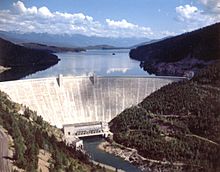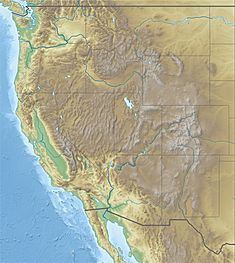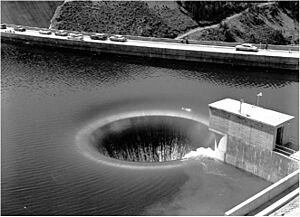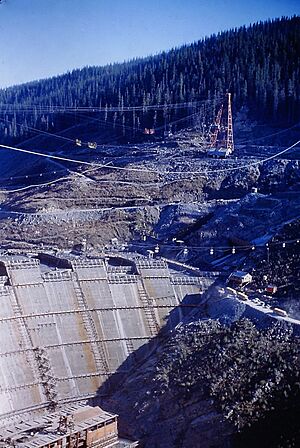Hungry Horse Dam facts for kids
Quick facts for kids Hungry Horse Dam |
|
|---|---|
 |
|
|
Location in western United States##Location in Montana
|
|
| Location | Flathead County, near Hungry Horse, Montana, U.S. |
| Coordinates | 48°20′28″N 114°00′50″W / 48.341°N 114.014°W |
| Construction began | April 21, 1948 |
| Opening date | July 18, 1953 72 years ago |
| Operator(s) | U.S. Bureau of Reclamation |
| Dam and spillways | |
| Type of dam | Concrete thick arch dam |
| Impounds | South Fork Flathead River |
| Height | 564 ft (172 m) |
| Length | 2,115 ft (645 m) |
| Width (crest) | 34 feet (10.4 m) |
| Width (base) | 320 feet (98 m) |
| Dam volume | 2,934,500 cu yd (2,243,600 m3) |
| Spillway type | Gated Morning Glory |
| Spillway capacity | 50,000 cu ft/s (1,400 m3/s) |
| Reservoir | |
| Creates | Hungry Horse Reservoir |
| Total capacity | 3,467,179 acre-feet (4.28 km3) |
| Catchment area | 1,640 square miles (4,200 km2) |
| Normal elevation | 3,560 feet (1,085 m) above sea level |
| Power station | |
| Type | Conventional |
| Hydraulic head | 520 ft (160 m) |
| Turbines | 4 x 107 MW Francis turbines |
| Installed capacity | 428 MW |
| Annual generation | 1,086,250,400 KWh (2012) |
The Hungry Horse Dam is a huge arch dam in the western U.S.. It stands on the South Fork Flathead River in the Rocky Mountains of northwest Montana. You can find it in Flathead National Forest in Flathead County. It's about 15 miles (24 km) south of Glacier National Park's west entrance. The dam is also 9 miles (14 km) southeast of Columbia Falls. The U.S. Bureau of Reclamation runs the Hungry Horse project, including the dam and its power plant. The main road to the dam starts in Hungry Horse.
The Hungry Horse Project was built for several reasons. These include controlling floods and helping boats travel on the river. It also helps manage river flow and creates electricity. Other uses include recreation, like boating and fishing. However, no irrigation systems were ever built for farming. The main goals of the dam today are to produce electricity and prevent floods. The dam, its reservoir, and the area around it are popular for fun activities.
Contents
Dam Size and Features
The Hungry Horse Dam is very tall, standing at 564 feet (172 meters). When it was finished in 1953, it was the third largest concrete dam in the world. It was also the second highest. The dam used about 3.1 million cubic yards (2.4 million cubic meters) of concrete.
The dam has a special spillway called a "morning glory structure." This is a large, funnel-shaped opening that lets extra water out of the reservoir. It's the highest morning glory spillway in the world. A large ring gate, 64 feet (20 meters) by 12 feet (3.7 meters), controls the spillway. The water level in the reservoir is 3,560 feet (1,085 meters) above sea level.
Building the Dam
Building the dam was approved by a law in 1944. In April 1948, the government hired companies to build the dam. The main contract was for $43.4 million. Another company was hired to move the river's water away during construction. Two timber companies cleared 7,000 acres (2,800 hectares) of land. This was to make space for the new reservoir.
Construction officially started with special events in June 1948. Workers poured the first concrete in September 1949. The project used a huge amount of concrete, about 3 million cubic yards (2.3 million cubic meters). Engineers used new ideas to make the concrete stronger. They added air to it to stop it from cracking in cold weather. They also mixed in "fly ash," which is a fine powder, to make the concrete more stable. Hungry Horse was the first dam built using these new methods. Sadly, 23 workers lost their lives during the construction.
The dam was finished on July 16, 1953. On October 1, 1953, President Harry S. Truman visited. He flipped a switch to start the dam's power generators. The road that goes across the dam opened to the public on November 2, 1953.
Generating Electricity
The Hungry Horse Dam helps create a lot of electricity. It does this in two ways. First, it makes power right at the dam itself. Second, it stores and releases water for other dams downstream. These dams are on the Flathead, Clark Fork, Pend Oreille, and Columbia rivers.
About one billion kilowatt-hours of electricity are made at Hungry Horse Dam each year. But that's not all! The water released from Hungry Horse helps make even more power. As this water flows through other power plants downstream, it generates about 4.6 billion kilowatt-hours of electricity every year.
The power generators at Hungry Horse Dam are in a building at the base of the dam. The dam was first designed with four generators, each making 71,250 kilowatts of power. This added up to 285 megawatts. In the 1990s, these generators were made more powerful. Now, each one can make 107,000 kilowatts. This means the dam can produce a total of 428 megawatts of electricity.
In the mid-1950s, an aluminum factory was built near the dam. It was located northeast of Columbia Falls.
Rivers and Streams Feeding the Reservoir
The Hungry Horse Reservoir gets its water from many smaller creeks and streams. Here are some of them:
- West side:
- Alpha Creek
- Beta Creek
- Doris Creek
- Endor Creek
- Lost Johnny Creek
- Alice Creek
- Maggie Creek
- Wounded Buck Creek
- Lid Creek
- Argall Creek
- Elya Creek
- Flossy Creek
- Clayton Creek
- Knieff Creek
- Emma Creek
- Pearl Creek
- Mazie Creek
- Graves Creek
- Baker Creek
- Emperor Creek
- Forest Creek
- Wheeler Creek
- Czar Creek
- Heinrude Creek
- Sullivan Creek
- Quintonkon Creek
- Battery Creek
- Clark Creek
- Elam Creek
- East side:
- Emery Creek
- Hungry Horse Creek
- Solander Creek
- Fire Creek
- Spring Meadow Creek
- Ada Creek
- Ryle Creek
- Seagrid Creek
- Dudley Creek
- Riverside Creek
- Murray Creek
- McInernie Creek
- Deep Creek
- Ruby Creek
- Clorinda Creek
- Canyon Creek
- Harris Creek
- Felix Creek
- Paint Creek
- Betty Creek
- Logan Creek
- South Fork Logan Creek
- Devils Corkscrew Creek
- Hoke Creek
- Baptiste Creek
- Deadhorse Creek
- Peters Creek
- Brush Creek
- Dry Park Creek
- South Fork Dry Park Creek





